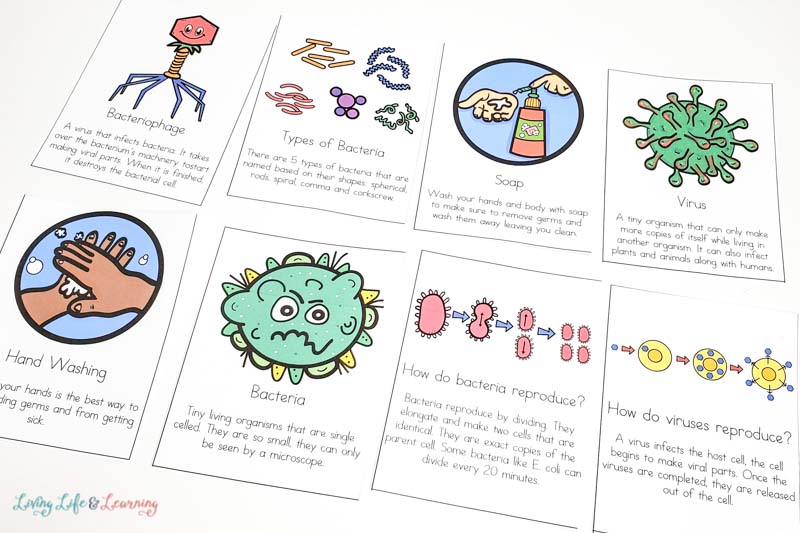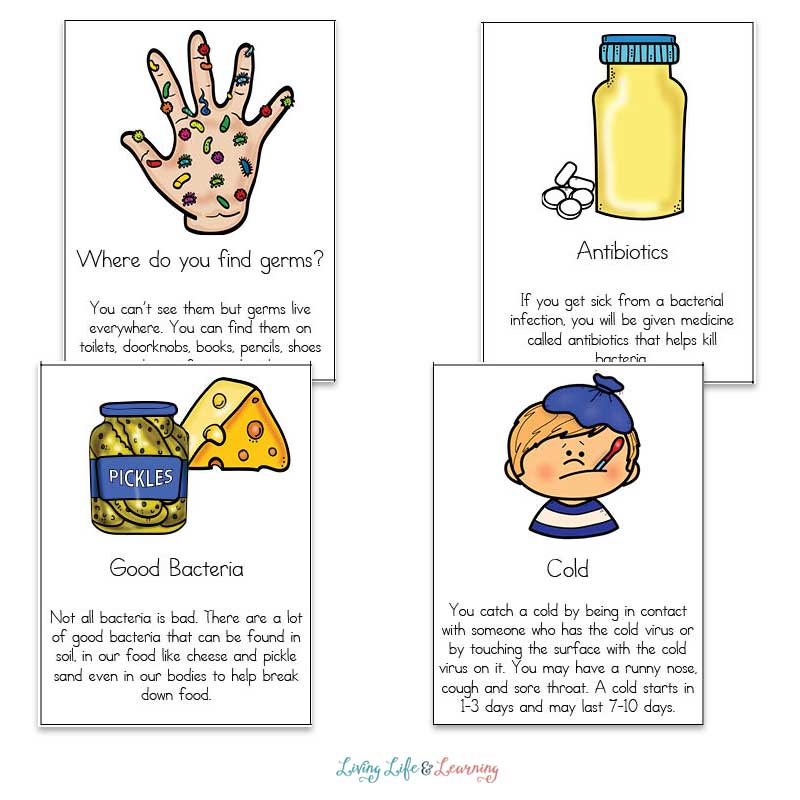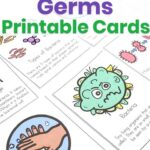Fighting Germs Printable Cards
Nobody likes to get sick! So we need to show our kids just what causes illness and how to prevent infections. Germs aren’t just “cooties” or gross sticky stuff that gets on us, but they are tiny living creatures that can be quite serious.
But that doesn’t mean we can’t have fun learning about how to fight germs. These fighting germs printable cards can help making learning about germs a fun game.
Loving this topic? See the other health worksheets for kids.
Germs are found all over the world, in just about every kind of place you can think of. These microscopic creatures are too small to see without help, but they are everywhere!
From the sole of your shoe to the inside of your pencil case, there are germs lurking in every corner. We’ve even found germs inside volcanos or at the bottom of icebergs!

This post may contain affiliate links meaning I get commissions for purchases made through links in this post. Read my disclosure policy here.
Recommended Germ Books for Kids
Learn all about what germs are, where they’re found and what we can do about them with these great books. And learn the difference between those organisms we call “germs” and the kinds of microbes that are actually very useful, even essential.
A great story can help bring topics to life, and good pictures with the facts can help long-term learning.
The Bacteria Book: The Big World of Really Tiny Microbes




Because germs are so tiny, we don’t know when we are at risk. But when we get attacked by germs, it can make us feel awful. Germs can infect in multiple ways, but there are some simple things we can do to make sure we don’t get sick.
Teaching kids about healthy food and habits? I have fun activities, printables, and more, on this list of Health and Hygiene for Kids.

What are germs?
Germs are tiny organisms that live on anything and everything. There are four different kinds of germs: bacteria, viruses, fungi and protozoa.
Fungi are plant-like creatures, but unlike plants, they live off other living things to get their nutrients. Things like mushrooms, molds, and moss are examples of fungi.
Most fungi aren’t harmful to humans, but sometimes, fungi will attach to humans and cause infection — like athlete’s foot fungi can cause rashes and itchiness on your toes. You can’t always see what the fungi looks like, until a bunch of fungi organisms grow together into something bigger.
Protozoa are special kinds of tiny organisms that love water and damp places. So sometimes, if the water you drink or wash in isn’t clean, they can get inside you and make your stomach hurt.
Viruses and bacteriophages aren’t actually cells at all, but pieces of living “code” that require other cells to live and reproduce. When they get inside a “host”, they take over and turn the host into a mini-factory that makes many copies of itself.
They don’t live very long outside a host, but they can spread quickly. And when they do infect, they often cause some irritating and even serious illnesses, like chicken pox, measles, or influenza.
Bacteria are tiny little organisms made up of a single cell, the building block of life. These are the smallest you can get and still be called alive. There are five different kinds of bacteria that we’ve named by their shapes.
And not all bacteria are bad!
Some can be quite useful, like the good bacteria that live inside our intestines and help us break down food to get the most out of it. But some bacteria is very bad for us, and can make us quite sick.

How do you spread germs?
Germs spread lots of ways — through water, air, and through touch. Usually, an infected person or animal spreads their germs by coughing, sneezing, or by touching things with germs on their hands.
Then someone who is uninfected comes by and breathes in the germs in the air or touches the same surface before it gets washed, then touches their nose, mouth or eyes and gets infected.
Sometimes germs can spread by poor hygiene, like not washing your hands enough or not cleaning surfaces enough. Sometimes it’s spread when things like the waste from the sewers spills into clean drinking water. And sometimes germs are spread by insect bites, like mosquitos.
We can prevent getting sick by doing some simple things, like washing our hands often. Plain soap and water can help keep hands and surfaces from spreading germs. And sometimes we have to do other things, like treat water with special chemicals to keep germs out, or use special chemicals to get rid of insects that spread germs.

How do germs reproduce
Germs reproduce in many different ways. It depends on what kind of germ it is.
Bacteria and protozoa are cells, so they reproduce the same way all cells do, by dividing themselves into copies. If bacteria can divide and reproduce quickly, they can be more dangerous.
Viruses reproduce by taking over the host cell and using it to make more viruses. Once the cell has filled up with multiple copies of the virus, it will burst and release all the viruses to find new hosts and make more copies.
Fungi reproduce by creating tiny little seed-like things called spores. Sometimes the spores can be more dangerous than the fungi, because they can spread faster. If spores get inside humans, they can cause infections, especially in the lungs.
Get the fighter germs cards and more health activities in the bundle below.
More Health Worksheets
Cleanliness Worksheets for Kindergarten
Hygiene Worksheet for Elementary Students










Thank you for this. I can’t wait to find some of these germs books to read to my 3 grandbabies who ages are 10 months, 2 years and 4 years old. And thank you for the free educational freebies. I’m not working so this helps out a lot. I stay home and watch them while my son and his wife works. Amy
Thanks for your feedback, I’m glad you’re enjoying my free resources.